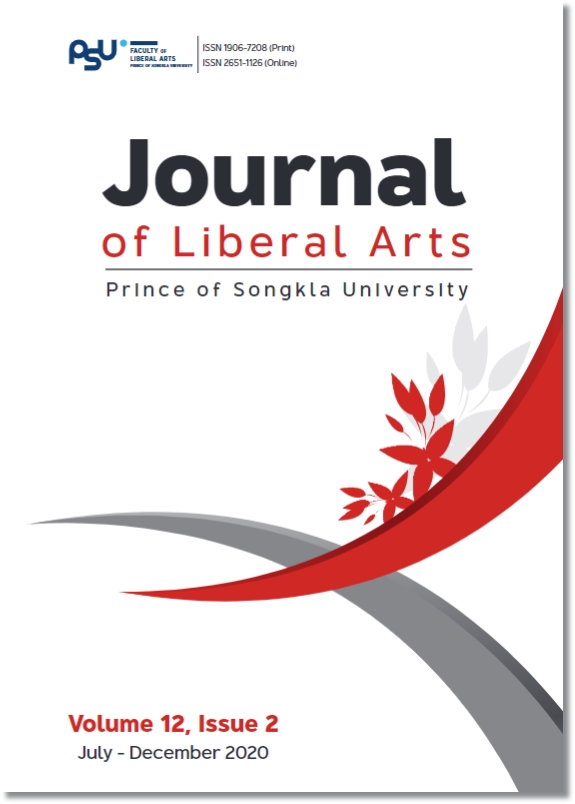ทัศนคติทางอ้อมของกลุ่มชาติพันธุ์มลายูปาตานี ต่อผู้พูดภาษามลายูปาตานีและผู้พูดภาษาไทยมาตรฐาน
คำสำคัญ:
ทัศนคติต่อภาษา, ภาษามลายูปาตานี, ชาติพันธุ์มลายูปาตานี, ภาษาไทย, มาตรฐานบทคัดย่อ
การศึกษานี้มีวัตถุประสงค์เพื่อศึกษาทัศนคติทางอ้อมต่อผู้พูดภาษามลายูปาตานีและผู้พูดภาษาไทยมาตรฐานของกลุ่มชาติพันธุ์มลายูปาตานีโดยใช้เทคนิคการพรางเสียงคู่ (matched-guise technique) กลุ่มตัวอย่างคือ กลุ่มชาติพันธุ์มลายูปาตานีเพศชายและเพศหญิงจำนวน 360 คน ที่อาศัยอยู่ในจังหวัดปัตตานี ยะลา และนราธิวาส วิธีการเก็บข้อมูลเป็นการให้กลุ่มตัวอย่างฟังเสียงพูด 4 เสียง จากผู้พูด 2 คน เพศหญิง 1 คน เพศชาย 1 คน ผู้พูดแต่ละคนจะพูดข้อความเดียวกันโดยใช้ภาษามลายูปาตานีและภาษาไทยมาตรฐาน กลุ่มตัวอย่างประเมินเสียงพูดที่ได้ยินตามคุณลักษณะต่าง ๆ ที่ระบุในแบบประเมินค่า ผลการศึกษาพบว่า ในภาพรวมกลุ่มตัวอย่างประเมินคุณลักษณะของผู้พูดภาษามลายูปาตานีและภาษาไทยมาตรฐานในระดับมากทุกคุณลักษณะ ยกเว้นคุณลักษณะ “รุนแรง” ที่ประเมินในระดับน้อย กลุ่มตัวอย่างประเมินผู้พูดภาษาไทยมาตรฐานว่ามีคุณลักษณะต่าง ๆ สูงกว่าผู้พูดภาษามลายูปาตานีในทุกด้าน ส่วนคุณลักษณะ “รุนแรง” ที่ประเมินในระดับน้อยก็ได้รับค่าคะแนนที่ต่ำกว่า ผลการศึกษายังแสดงให้เห็นได้อย่างชัดเจนด้วยค่าคะแนนเฉลี่ยที่พบว่า กลุ่มชาติพันธุ์มลายูปาตานีทุกเพศและทุกช่วงอายุมีทัศนคติที่ดีต่อผู้พูดภาษาไทยมาตรฐานดีเป็นอย่างมาก ซึ่งสิ่งนี้แสดงนัยให้เข้าใจได้ว่า เมื่อมีทัศนคติที่ดีต่อผู้พูดภาษาไทยมาตรฐาน ย่อมมีทัศนคติที่ดีต่อภาษาไทยมาตรฐาน ซึ่งก็เป็นภาษาราชการของประเทศด้วย ตามหลักการและแนวคิดทัศนคติต่อภาษาที่กล่าวว่าภาษามีความสัมพันธ์กับตัวผู้พูด ทัศนคติต่อผู้พูดภาษาจึงหมายรวมถึงทัศนคติที่มีต่อภาษานั้น ๆ ด้วย
เอกสารอ้างอิง
Chanyam, N. (2002). Study of language attitude toward Thai dialects and their speakers: A case study of four campuses of Rajamagala Institute of Technology [Unpublished master’s thesis]. Mahidol University.
Crystal, D. (1992). The Cambridge encyclopedia of language. Cambridge University Press.
Garrett, P. (2010). Attitudes to language: Key topics in sociolinguistics. Cambridge University Press.
Holmes, J. (2013). An introduction to sociolinguistics. (4th ed.). Edinburgh: Pearson Education Limited.
Lambert, W., Hodgson, R. G., & Fillenbaum, S. (1960). Evolutional reactions to spoken languages. Journal of Abnormal and Social Psychology, 60, 44-51.
Meyerhoff, M., Schloeef, E., & MacLenzie, L. (2015). Doing sociolinguistics: A practical guide to data collection and analysis. Routledge.
Osgood, C. E., Suci, G., & Tannenbaum, P. (1957). The measurement of meaning. University of Illinois Press.
Prasithrathsint, A. (1989). Definitions in sociolinguistics. Bangkok: Chulalongkorn University Printing House. [In Thai]
Premsrirat, S., Diphadung, S., Suwanket, E., Buasuang, A., Choosri, I., & Srichampa, S. (2004). Ethnolinguistic maps of Thailand. Office of the National Culture Commission. [In Thai]
Premsrirat, S., et al. (2007). Malay dialects in Thailand: Language situation survey and language planning, language development or effective education and mass communication in southern border provinces of Thailand. Resource Center for Documentation, Revitalization and Maintenance of Endangered Languages and Cultures, Research Institute for Languages and Cultures in Asia, Mahidol University. [In Thai]
Royal Institute of Thailand. (2010). Manual for Thai – based Patani Malay writing system. Bangkok: Sahamitr Printing and Publishing Co., Ltd. [In Thai]
Royal Institute of Thailand. (2010). Dictionary of linguistics (Applied linguistics), Royal Institute of Thailand edition. Rungsilp Printing Co., Ltd. [In Thai]
ดาวน์โหลด
เผยแพร่แล้ว
รูปแบบการอ้างอิง
ฉบับ
ประเภทบทความ
สัญญาอนุญาต
ลิขสิทธิ์บทความเป็นของผู้เขียน แต่วารสารศิลปศาสตร์ มหาวิทยาลัยสงขลานครินทร์ ขอสงวนสิทธิ์ในการเป็นผู้ตีพิมพ์เผยแพร่เป็นครั้งแรก






